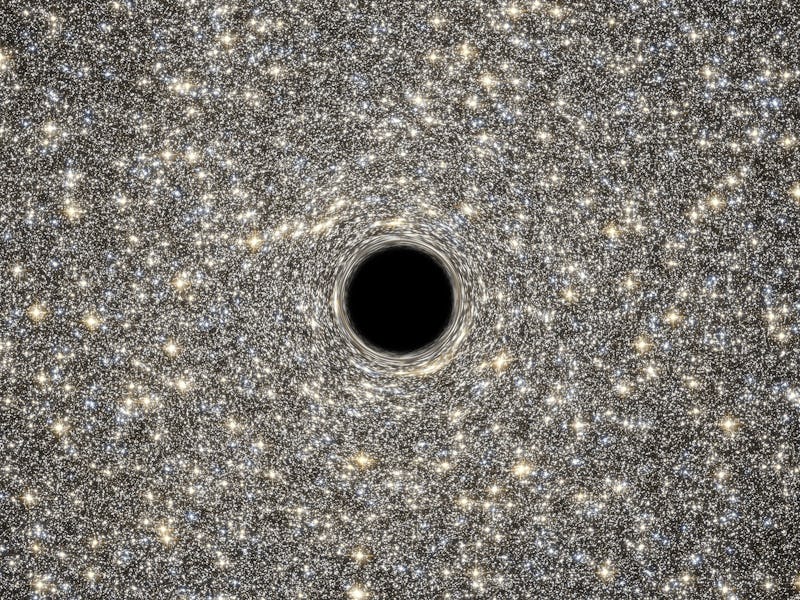Dark Matter "Test" Will Either Prove Its Existence or Modify Gravity

For something that supposedly takes up 80 percent of the total mass of the universe, we don’t know a whole lot about dark matter. Sometimes the lightless stuff reveals hints about its shape; other times it completely thwarts any evidence supporting its existence. Since we can’t observe it first-hand, we rely on indirect means to suss out information about it, like watching the interactions between other forms of matter. Now, scientists have developed a new “test” to make those investigations more definitive, leading us closer to answering the question: Is dark matter even real? And if it’s not, then is everything we know about gravity wrong?
In a study, published Monday in Physical Review Letters, a team of scientists from the University of Bonn that also includes Hubble Fellow Marcel S. Pawlowski, Ph.D. of the University of California, Irvine, introduce a computer model that can simulate how certain small galaxies should move if dark matter exists. Though dark matter does not absorb or emit light, it still interacts with visible matter through gravity, so it’s expected to make the stars around galaxies move in specific ways.
Pawlowski explains to Inverse in an email that within the little galaxies in question — satellite “dwarf” galaxies, crowding around the edges of big galaxies like the Milky Way — the acceleration of stars speeding around the galaxy’s center is described by a term called the radial acceleration relation, or RAR. “With the new study, we simulate such dwarf galaxies under the assumption of the ‘standard’ dark matter model, [to] determine what kind of behavior would be expected for the dwarfs,” he says. “We find that the simulated dwarf galaxies largely continue the RAR to lower accelerations.” Now that they know how those dwarf galaxies are supposed to move if dark matter exists, they can compare the simulations to real-life data on the movement of those galaxies.
NASA uses images like this one, showing faint background galaxies whose light is bent by the cluster's gravitational field, to deduce how dark matter is distributed in the cluster.
So, the team made those comparisons and got some weird results. “In our study, we determine how dwarf galaxies within the dark matter paradigm would align with the RAR. Thus far, this was unclear, they could have shown wide scatter, for example,” says Pawlowski, referring to the “scattering” of data points away from the trend you might expect if dark matter really exists. “We find that they don’t, which differs from the observed situation.” In other words, what they found suggests that the real-life RAR of dwarf galaxies doesn’t match up with the RAR in the dark matter simulation. But the team doesn’t believe that this is enough evidence to say that this is evidence against dark matter.
“Most likely that is because the observational data is not precise enough, such that observational uncertainties dominate the scatter,” says Pawlowski. As with so many scientific studies, more data is needed.
“However, if better observations confirm that dwarf galaxies show a larger scatter around the RAR than our simulations, this could even be seen as evidence against dark matter,” he says. “So, we have developed a test that promises to decide between the two possibilities — dark matter or modified gravity — but the jury is still out until we get better data.”
We’ve relied on Isaac Newton’s law of universal gravitation for over 300 years, and it’s been sufficient to explain most of the stuff that happens on Earth. But lately, as scientists have probed dark matter in the universe, it seems as though the law isn’t as all-encompassing as we need it to be. To take into account all of the data that don’t fit our theory of how gravity works, some scientists have suggested a law called Modified Newtonian Dynamics (MOND). Since the preliminary results from the current study suggest that the RAR of dwarf galaxies don’t correspond with what you might expect from a universe where dark matter exists, then it may be time to seriously consider MOND.
The stars in satellite dwarf galaxies, like the one pictured here, are thought to move according to RAR.
“From a dark matter perspective, the RAR is a really weird finding,” says Pawlowski. “It says that once you know how the mass in stars and gas are distributed in a galaxy, you can precisely predict its dynamics, such as how fast a spiral galaxy rotates. That’s counter-intuitive because in the dark matter framework, the mass in stars and gas is negligible compared to the invisible dark matter. The latter should dominate the dynamics. Thus the stars and gas shouldn’t determine how a galaxy rotates, because its dark matter can in principle be distributed in many different ways, independent of what the stars and gas do.”
But when you use a MOND framework, he says, “the RAR behavior is exactly what you expect: There is no dark matter, the stars and gas determine the dynamics of galaxies.”
It’s heady stuff, but fortunately, there’s still a lot of investigating and data collecting left to do before we are faced with the decision to shift humanity’s understanding of gravity. Understanding the nature of dark matter may not change your day to day existence, but who wouldn’t want to shed light on the stuff that surrounds us that we cannot see?